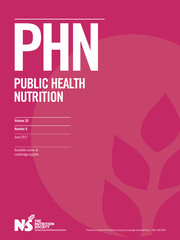Monitoring and surveillance
Research Papers
Media audit reveals inappropriate promotion of products under the scope of the International Code of Marketing of Breast-milk Substitutes in South-East Asia
-
- Published online by Cambridge University Press:
- 15 March 2017, pp. 1333-1342
-
- Article
-
- You have access
- Open access
- HTML
- Export citation
Hypertension and diabetes prevalence among adults with moderately increased BMI (23·0–24·9 kg/m2): findings from a nationwide survey in Bangladesh
-
- Published online by Cambridge University Press:
- 23 January 2017, pp. 1343-1350
-
- Article
-
- You have access
- HTML
- Export citation
Assessment and methodology
Research Papers
Comparing intake estimations based on food composition data with chemical analysis in Malian women
-
- Published online by Cambridge University Press:
- 08 February 2017, pp. 1351-1361
-
- Article
-
- You have access
- HTML
- Export citation
Using cross-sectional surveys to estimate the number of severely malnourished children needing to be enrolled in specific treatment programmes
-
- Published online by Cambridge University Press:
- 24 January 2017, pp. 1362-1366
-
- Article
-
- You have access
- HTML
- Export citation
Short Communications
Brief assessment of food insecurity accurately identifies high-risk US adults
-
- Published online by Cambridge University Press:
- 20 February 2017, pp. 1367-1371
-
- Article
-
- You have access
- HTML
- Export citation
Nutritional status and body composition
Research Papers
Eating frequency in relation to BMI in very young children: a longitudinal analysis
-
- Published online by Cambridge University Press:
- 27 February 2017, pp. 1372-1379
-
- Article
-
- You have access
- HTML
- Export citation
Going flat: examining heterogeneity in the soda–obesity relationship by subgroup and place of birth among Asian Americans
-
- Published online by Cambridge University Press:
- 24 February 2017, pp. 1380-1387
-
- Article
-
- You have access
- HTML
- Export citation
Behavioural nutrition
Short Communications
Examining the feasibility of implementing behavioural economics strategies that encourage home dinner vegetable intake among low-income children
-
- Published online by Cambridge University Press:
- 15 March 2017, pp. 1388-1392
-
- Article
-
- You have access
- HTML
- Export citation
Research Papers
Regular breakfast consumption is associated with higher blood vitamin status in adolescents: the HELENA (Healthy Lifestyle in Europe by Nutrition in Adolescence) Study
-
- Published online by Cambridge University Press:
- 10 February 2017, pp. 1393-1404
-
- Article
-
- You have access
- HTML
- Export citation
Haemoconcentration risk at the end of pregnancy: effects on neonatal behaviour
-
- Published online by Cambridge University Press:
- 06 February 2017, pp. 1405-1413
-
- Article
-
- You have access
- HTML
- Export citation
Economics and environment
Research Papers
The growing disconnect between food prices and wages in Europe: cross-national analysis of food deprivation and welfare regimes in twenty-one EU countries, 2004–2012
-
- Published online by Cambridge University Press:
- 20 March 2017, pp. 1414-1422
-
- Article
-
- You have access
- HTML
- Export citation
How expensive is a cardioprotective diet? Analysis from the CRESSIDA study
-
- Published online by Cambridge University Press:
- 18 January 2017, pp. 1423-1430
-
- Article
-
- You have access
- HTML
- Export citation
Fluctuations in money availability within an income cycle impacts diet quality of remote Indigenous Australians
-
- Published online by Cambridge University Press:
- 10 January 2017, pp. 1431-1440
-
- Article
-
- You have access
- HTML
- Export citation
Community nutrition
Research Papers
Does breast-feeding reduce offspring junk food consumption during childhood? Examinations by socio-economic status and race/ethnicity
-
- Published online by Cambridge University Press:
- 20 January 2017, pp. 1441-1451
-
- Article
-
- You have access
- HTML
- Export citation
Short Communications
Low-income adults’ perceptions of farmers’ markets and community-supported agriculture programmes
-
- Published online by Cambridge University Press:
- 16 February 2017, pp. 1452-1460
-
- Article
-
- You have access
- HTML
- Export citation
Interventions
Research Papers
Effects of a community-based nutrition promotion programme on child feeding and hygiene practices among caregivers in rural Eastern Ethiopia
-
- Published online by Cambridge University Press:
- 27 December 2016, pp. 1461-1472
-
- Article
-
- You have access
- HTML
- Export citation
Impact of two policy interventions on dietary diversity in Ecuador
-
- Published online by Cambridge University Press:
- 06 February 2017, pp. 1473-1480
-
- Article
-
- You have access
- HTML
- Export citation
Exclusive breast-feeding promotion among HIV-infected women in South Africa: an Information–Motivation–Behavioural Skills model-based pilot intervention
-
- Published online by Cambridge University Press:
- 08 February 2017, pp. 1481-1490
-
- Article
-
- You have access
- HTML
- Export citation
Potential in-class strategies to increase children’s vegetable consumption
-
- Published online by Cambridge University Press:
- 16 February 2017, pp. 1491-1499
-
- Article
-
- You have access
- HTML
- Export citation
Public policies
Research Papers
Salt and sugars content of breakfast cereals in the UK from 1992 to 2015
-
- Published online by Cambridge University Press:
- 07 February 2017, pp. 1500-1512
-
- Article
-
- You have access
- HTML
- Export citation



